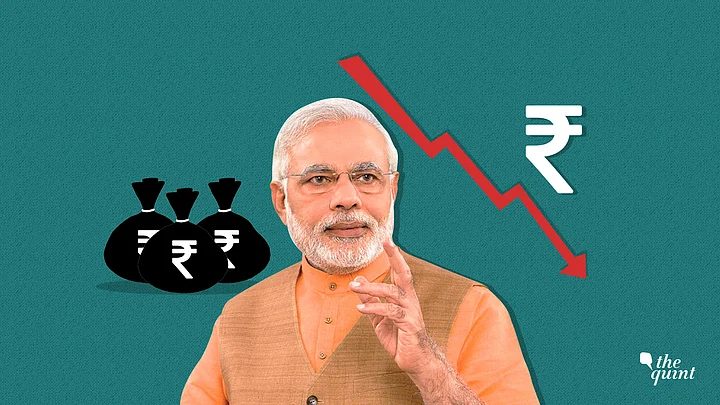Doubts over the veracity of the new series of GDP launched in 2015 have resurfaced after a new National Sample Survey Office (NSSO) report showed that around 36 percent of companies in the MCA-21 database, used for GDP calculation, could not be traced or surveyed.
“Out of the 36 percent out-of-survey units in MCA, 21 percent were found to be out of coverage and another 12 percent were non-traceable (which in number is nearly 4,000 units),” said the report.
These companies were described as "active" companies by the Ministry of Corporate Affairs.
This revelation casts further shadow on the new series of GDP data, which had showed significant drop in the growth estimate for the UPA administration.
WHAT IS THE CONTROVERSY?
In 2015, the Narendra Modi-led government had decided to change the base year for GDP calculations (from 2004-2005 to 2011-12).
This, in turn, had resulted in a significant drop in the corresponding growth estimates for the erstwhile UPA government, giving a boost – by comparison – to the current dispensation.
Given the findings of the NSSO report, concerns are being raised over the reliability of this new data – that is purportedly full of holes.
WHAT’S WRONG WITH MCA-21 DATA?
These companies listed in the MCA-21 database were described as "active" companies by the Ministry of Corporate Affairs.
R Nagaraj, a professor at the Indira Gandhi Institute of Development Research in Mumbai, told IANS that this report vindicates the critics' stand, including his own, on doubts over the MCA data.
“This is a damaging report for the CSO,” Nagaraj said, as per IANS.
"The general criticism was that there was a large proportion of these so called active could be non-working companies. They may not be producing goods and services, although they legally exist on paper," he told the news agency. Nagaraj was among the first people to raise concerns over this.
The report noted that non-response of a large number of units was a major setback for the survey. "This happened due to unit non-response, closure of the unit, unit found to be the one other than headquarter, unit out of coverage or unit non-traceable," it said.
HOW DOES THIS AFFECT GDP CALCULATION?
The recent figures raise fresh concerns as the older GDP series relied on a survey of companies conducted by the Reserve Bank of India for the private corporate sector, while the newer one employed the 'MCA-21' database maintained by the Ministry of Corporate Affairs that contains a list of registered companies.
In the appendix of the report titled Technical Report on Services Sector Enterprises in India, NSSO said: "Many units, particularly of MCA list were not identifiable due to lack of proper or adequate postal addresses. Therefore, many notices could not be delivered."
The report observed that in many cases, the selected enterprises either did not prepare their annual audit reports for 2015-16 or did not prepare balance sheets any time before.
"This resulted in delay in the progress of the survey and increase in the number of non-response cases," it said.
The NSSO’s 74th round survey was a first of its kind survey for the service sector in the country.
GOVT TO BLAME?
PC Mohanan, former NSC member and former NSSO chief, told LiveMint that the MCA-21 database did not receive the scrutiny it should have.
“The CSO should have done some kind of critical scrutiny and validation before using the MCA-21 database in the new GDP series, either through quick surveys or by comparing with other databases, or consultations with accountants familiar with company filings," said Mohanan.
Mohanan had resigned from NSC in December over the suppression of an NSSO jobs report.
“That kind of critical examination was always done by CSO whenever they introduced new databases earlier, but I am not sure if MCA-21 data was examined in the same manner. This was all the more important because unlike other databases such as ASI or NSSO surveys used by CSO, this database is not publicly available," he said, as per the report.
Pronab Sen, India's former Chief Statistician, however, denied that the revelation cast shadow on the GDP data, but said that it shows that "there are many more shell companies than we had thought."
He suggested that the new government should take note of the concerns over veracity of statistical data in the country.
"I would seriously hope that the new government would take the recent incidents seriously and give the statistical system the autonomy which is required," Sen added.
WHAT DO EXPERTS SAY?
Economic experts said that the NSSO report had dealt a devastating blow to the new GDP series.
Investor and poll-watcher Ruchir Sharma, meanwhile, said that the new GDP calculations had failed the ‘sniff test’ back in 2015 itself.
“How can an economy be growing at 7-8 percent, when every other economic indicator like cement sales, two-wheeler sales, exports were at 20-30 percent for that time period,” he said, while speaking at the Express Adda in New Delhi.
OPPOSITION SLAMS BJP
Opposition parties were quick to latch on to the report, slamming the ruling dispensation over the purported discrepancy in its data.
(With inputs from LiveMint, IANS)
(At The Quint, we question everything. Play an active role in shaping our journalism by becoming a member today.)
